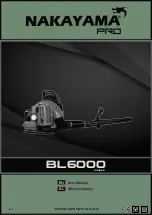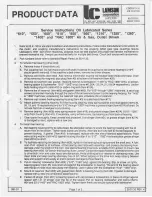
Operating instructions
G1G126-AA49-71
Translation of the original operating instructions
1.10 Hot surface
CAUTION
High temperature on electronics housing
Risk of burns
→ Ensure sufficient protection against accidental contact.
1.11 Transport
NOTE
Transporting the blower
→ Transport the blower in its original packaging only.
→ Secure the blower so it cannot slip, e.g. by using a
lashing strip.
NOTE
Transporting the device
→ Transport the device in its original packaging only.
1.12 Storage
;
Store the device, partially or fully assembled, in a dry place,
protected against the weather and free from vibration, in the original
packaging in a clean environment.
;
Protect the device against environmental effects and dirt until final
installation.
;
We recommend storing the device for no longer than one year in
order to guarantee trouble-free operation and the longest possible
service life.
;
Even devices explicitly intended for outdoor use are to be stored as
described prior to commissioning.
;
Maintain the storage temperature, see
Chapter 3.5 Transport and storage conditions.
2. INTENDED USE
The device is exclusively designed as a built-in device for conveying
air and gases according to its technical data.
Any other usage above and beyond this does not conform with the
intended purpose and constitutes misuse of the device.
Customer equipment must be capable of withstanding the mechanical
and thermal stresses that can arise from this product. This applies for the
entire service life of the equipment in which this product is installed.
Intended use also includes
●
Conveying air in gas burners.
●
conveying air at an ambient air pressure between 750 mbar and 1050
mbar.
●
Following the operating instructions.
●
Using the device within the permitted ambient temperature range; see
Chapter 3.5 Transport and storage conditions and
Chapter 3.2 Nominal data.
●
Using the device only in stationary systems.
●
Installing the device in an integrated system for conveying air.
●
Commissioning the built-in component only after installation in the
customer equipment.
●
Operating the device with all protective devices.
●
Use of the device in stationary systems only.
Improper use
In particular, operating the device in the following ways is prohibited and
could be hazardous:
●
Operating the device in an unbalanced state, e.g. due to dirt deposits
or ice formation.
●
Resonant operation, operation with severe vibration. This also
includes vibration transmitted to the fan from the customer installation.
●
Conveying a medium that contains abrasive particles.
●
Conveying a highly corrosive medium.
●
Conveying a medium with high dust content, e.g. suctioning off
sawdust.
●
Operating the gas blower in an environment that contains flammable
gases or dust or combustible solids or fluids.
●
Conveying air/gas mixtures outside of an integrated system
satisfying the requirements described above.
●
Using the blower as a safety component or to perform safety-related
functions.
●
Operation in medical equipment with a life-sustaining or life-support
function.
●
Contact with materials that could damage blower parts, e.g. liquids
during cleaning.
●
Operation with completely or partially disassembled or manipulated
protective devices.
●
Exposure to radiation which could damage blower parts, e.g. strong
UV radiation.
●
Operation with external vibrations.
●
Operating the device in an explosive atmosphere.
●
Operation with completely or partially disassembled or manipulated
protective devices.
●
In addition, all applications not listed among the intended uses.
Item no. 51256-5-9970 · ENU · Change 202174 · Approved 2018-12-27 · Page 3 / 12
ebm-papst Mulfingen GmbH & Co. KG · Bachmühle 2 · D-74673 Mulfingen · Phone +49 (0) 7938 81-0 · Fax +49 (0) 7938 81-110 · info1@de.ebmpapst.com · www.ebmpapst.com






























